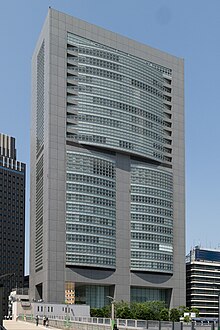 | |
 Headquarters in Shibuya ward, Tokyo | |
Native name | 東日本旅客鉄道株式会社 |
|---|---|
Romanized name | Higashi-Nihon Ryokaku Tetsudō kabushiki gaisha lit. 'East Japan Passenger Railway Share Company' |
| Company type | Public |
| |
| Industry | Rail transport |
| Predecessor | Japanese National Railways (JNR) |
| Founded | 1 April 1987, privatization of JNR |
| Headquarters | 2-2-2 Yoyogi, Shibuya, Tokyo , Japan |
Area served | Kanto and Tōhoku regions Niigata, Nagano, Yamanashi and Shizuoka prefectures |
Key people | Tetsuro Tomita (chairman of the board) Masaki Ogata (vice chairman of the board) Yuji Fukasawa (president, Representative Director)[1] |
| Products | Suica (a rechargeable contactless smart card) |
| Services | Passenger railways freight services bus transportatio other related services[2] |
| Revenue | |
| Total assets | |
| Total equity | |
| Owner | JTSB investment trusts (8.21%) Mizuho Bank (4.07%) TMTBJ investment trusts (3.97%) MUFG Bank (2.75%) Repurchased shares (2.67%) (as of 30 September 2018) |
Number of employees | 73,017 (as of 31 March 2013)[1] |
| Divisions | Railway operations[5] Life-style business[5] IT & Suica business[5] |
| Subsidiaries | 83 companies,[6][7] including Tokyo Monorail and J-TREC |
| Website | www |
| Footnotes / references [8][9] | |
The East Japan Railway Company[10] is a major passenger railway company in Japan and the largest of the seven Japan Railways Group companies. The company name is officially abbreviated as JR-EAST[11] or JR East in English, and as JR Higashi-Nihon (JR東日本, Jeiāru Higashi-Nihon) in Japanese. The company's headquarters are in Yoyogi, Shibuya, Tokyo, next to Shinjuku Station.[2] It is listed in the Tokyo Stock Exchange (it formerly had secondary listings in the Nagoya and Osaka stock exchanges), is a constituent of the TOPIX Large70 index, and is one of three Japan Railways Group constituents of the Nikkei 225 index, the others being JR Central and JR West.
- ^ a b "JR East 2013 Annual Business Report (Japanese)" (PDF). East Japan Railway Company. Archived from the original (PDF) on 13 November 2013. Retrieved 25 June 2013.
- ^ a b "JR East Corporate Data". East Japan Railway Company. Archived from the original on 4 March 2016. Retrieved 27 August 2023.
- ^ a b East Japan Railway Company. "Financial Report 2023" (PDF). p. 3. Archived (PDF) from the original on 28 August 2023. Retrieved 27 August 2023.
- ^ a b c d e f East Japan Railway Company. "Financial Highlights - East Japan Railway Company and Subsidiaries" (PDF). Archived (PDF) from the original on 31 January 2023. Retrieved 31 January 2023.
- ^ a b c "Organization". East Japan Railway Company. Archived from the original on 27 October 2022. Retrieved 20 June 2009.
- ^ East Japan Railway Company. グループ会社一覧 (in Japanese). Archived from the original on 27 October 2022. Retrieved 20 June 2009.
- ^ 会社要覧2008 (PDF) (in Japanese). East Japan Railway Company. Archived (PDF) from the original on 22 April 2023. Retrieved 20 June 2009.
- ^ "Consolidated Results of Fiscal 2011 (Year Ended 31 March 2011)" (PDF). East Japan Railway Company. Archived (PDF) from the original on 20 March 2023. Retrieved 27 April 2011.
- ^ "JR East 2012 Annual Report" (PDF). East Japan Railway Company. Archived (PDF) from the original on 31 December 2022. Retrieved 16 February 2013.
- ^ 東日本旅客鉄道株式会社, Higashi-Nihon Ryokaku Tetsudō kabushiki gaisha
- ^ "JR-EAST – East Japan Railway Company". East Japan Railway Company. Archived from the original on 3 October 2016. Retrieved 1 October 2016.